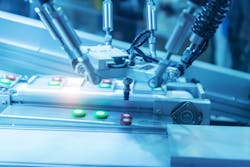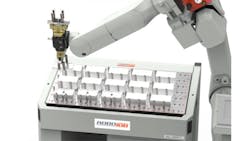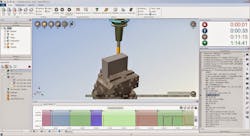Integrating CNC Machines and Automation for Smarter Manufacturing
The Computer Numerical Controls (CNC) market is set to grow due to the demand of production efficiency. CNC machines have been a staple of manufacturers but they are now being paired with automation systems and simulation software to increase production. The addition of 3D printing machines onto the factory floor has also increased the demand of CNC machines, since they are used for the surface finishing of 3D printed objects. When implementing CNC machines there are some tips and best practices because even automated CNC machines need human supervision.
The robotic arm featured above from RoboJob is an example of how automation can be integrated into milling and other CNC operations.
Background on CNC Machines
CNC machines were first developed and introduced between the 1940s to 1950s. They relied on punched tape or perforated paper tape for common telecommunication data storage technology. This quickly transitioned to analog and then eventually digital computer processing. CNCs rely on digital instructions from computer-aided manufacturing (CAM) or computer-aided design (CAD). The CNC machine then interprets the design from the CAM/CAD instructions.
CNC machines are now benefiting from automation to make more precise parts and are aiding emerging technologies by producing quicker parts. The video below describes how 3D printing and CNC machines are being used side by side.
Advanced programming rapidly increases shop productivity and automating the processes simplifies the production and reduces the intensity of the labor. Automated cuts improve both speed and accuracy, which is especially helpful when producing prototype parts. Most of the time a single tool will not suffice for part production and CNC machines will be combined into common units or cells where the machines can draw different tools from. Conventional technologies are:
Drills: Work by spinning a drill bit and removing material by passing the bit around stationary block of stock material.
Lathes: Are the inverse of drills as the block of material spins against the drill bit. They make contact by the moving the cutting toll until it touches the spinning material.
Milling: The most common CNC used today. They use rotary cutting tools to remove material.
Electrical/Chemical Machining: These technologies remove material by using electron beam, lasers, or chemicals. Examples are electron beam machining, electrochemical machining, electrical discharge machining, photochemical machining, and ultrasonic machining.
The Growing Market
The global CNC market is being led by lathe machines and they will be the dominating machine through the forecast period. Transparency Market Research predicts that the U.S. value will increase from $52.6 billion in 2015 to $93.4 billion in 2024 led by lathe machines. Their large application area is why they are leading the market. Milling machines are also estimated to have strong growth. The area of strongest growth is the Asia Pacific market. In 2015, they led the market by 30% and with a market revenue share of $19.04 billion. The biggest industry of growth is the automotive sector for both China and India. The United States, one of the earliest adopters of CNC machines, is already a crowded market. It will most likely see the highest integration of CNC machines with automated systems.
NCSIMUL Machine module, part of its NCSIMUL Solutions 10, is an example of how simulation can be used for CNC programming to help increase productivity and efficiency.
How to Properly Integrate CNC and Automation
While the benefits of CNC and automation are clear there are still barriers to overcome. The primary assumption of many is that CNC machines can be left unattended once they have been automated; running all night and weekend in the dark. This is untrue. According to MoldMakingTechnology.com, CNC machines can be set up to run finishing cuts and operations at night by only if done properly by the operator. They must inspect the cutting tool is not worn out and that the programmed parameters are set. The CNC machine will not detect wear on a tool bit. The thermal expansion of the machine is another parameter that must be carefully monitored. While thermal expansion algorithms can help predict when a tool is out of tolerance, operators are still need to adjust warning indicators and perform measurements on the tool after machining processes are complete; changing the tool if necessary.
The investment in resources will be also important. Not just in new machines or connection equipment (i.e. robotic arms, Ethernet systems, sensors, machine vision, etc.) but also in the labor work force. Advances in solid modeling, CAM/CAD systems, and computer integration have helped several operators create millions of lines of code to perform several operations. Companies need to invest into computer programmers and software modelers to handle the increased amount of computer data needed to operate these machines.



